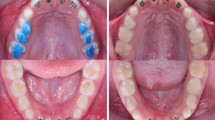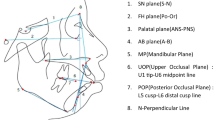Abstract
Objective:
The purpose of this prospective, longitudinally-controlled study was to analyze the isolated effect of spurs on the craniofacial and dentoalveolar complex of patients presenting anterior open bite due to tongue dysfunction.
Material and Methods:
Following a standardized treatment protocol, fifteen patients (mean age 13 years, 10 months ± 5 years, 7 months) underwent treatment with a fixed palatal spur appliance for a mean duration of 9.13 months. The cephalometric analysis was based on lateral cephalograms taken before (T1) and directly after the spur therapy (T2).
Results:
All patients experienced an elongation of the maxillary and mandibular alveolar processes. The alveolar process height of the maxilla showed a highly significant mean growth increment of 1.61 mm, the alveolar process height of the mandible of 1.36 mm. The mean increase in overbite was 1.95 mm and highly significant. In addition, after spur therapy, a significant uprighting of the lower incisors was observed, which also resulted in a significant increase in the overjet.
Conclusions:
With the help of spurs, an elongation of the alveolar process heights of the upper and lower jaws was achievable for all patients presenting an anterior open bite due to tongue dysfunction. The results indicate a change in the neuromuscular behavior pattern of the tongue which brought about the correction of the dysfunction and, finally, the increase in overbite.
Zusammenfassung
Ziel:
Ziel der prospektiv, longitudinal kontrollierten Studie war es, den isolierten Effekt von Spikes auf den kraniofazialen und dentoalveolären Komplex bei Patienten mit anterior offenem Biss bedingt durch eine Zungendysfunktion zu analysieren.
Material und Methodik:
Bei 15 Patienten (Durchschnittsalter 13 Jahre, 10 Monate ± 5 Jahre, 7 Monate) wurde nach standardisiertem Behandlungsprotokoll eine Spike-Apparatur im Oberkiefer fest eingesetzt und für durchschnittlich 9,13 Monate belassen. Zur kephalometrischen Analyse wurden Fernröntgenseitenbilder vor (T1) und direkt nach der Spike-Therapie (T2) angefertigt.
Ergebnisse:
Die Alveolarfortsatzhöhe von Maxilla und Mandibula verlängerte sich bei allen Patienten. So wies die Alveolarfortsatzhöhe der Maxilla einen höchst signifikanten Zuwachs um durchschnittlich 1,61 mm auf, die Alveolarfortsatzhöhe der Mandibula um 1,36 mm. Der Overbite vergrößerte sich hochsignifikant um durchschnittlich 1,95 mm. Zusätzlich konnte eine signifikante Aufrichtung der unteren Inzisivi nach Spike-Therapie nachgewiesen werden, wodurch sich auch der Overjet signifikant vergrößerte.
Schlussfolgerungen:
Mit Hilfe von Spikes konnte bei allen Patienten eine Verlängerung der Alveolarfortsatzhöhen von Oberund Unterkiefer im Rahmen eines durch Zungendysfunktion bedingten anterior offenen Bisses erreicht werden. Die Ergebnisse sprechen für eine Veränderung des neuromuskulären Bewegungsmusters der Zunge, wodurch die Korrektur der Dysfunktion und letztlich eine Bissvertiefung erreicht wurden.
Similar content being viewed by others
Author information
Authors and Affiliations
Corresponding author
Rights and permissions
About this article
Cite this article
Meyer-Marcotty, P., Hartmann, J. & Stellzig-Eisenhauer, A. Dentoalveolar Open Bite Treatment with Spur Appliances. J Orofac Orthop 68, 510–521 (2007). https://doi.org/10.1007/s00056-007-0707-0
Received:
Accepted:
Issue Date:
DOI: https://doi.org/10.1007/s00056-007-0707-0




